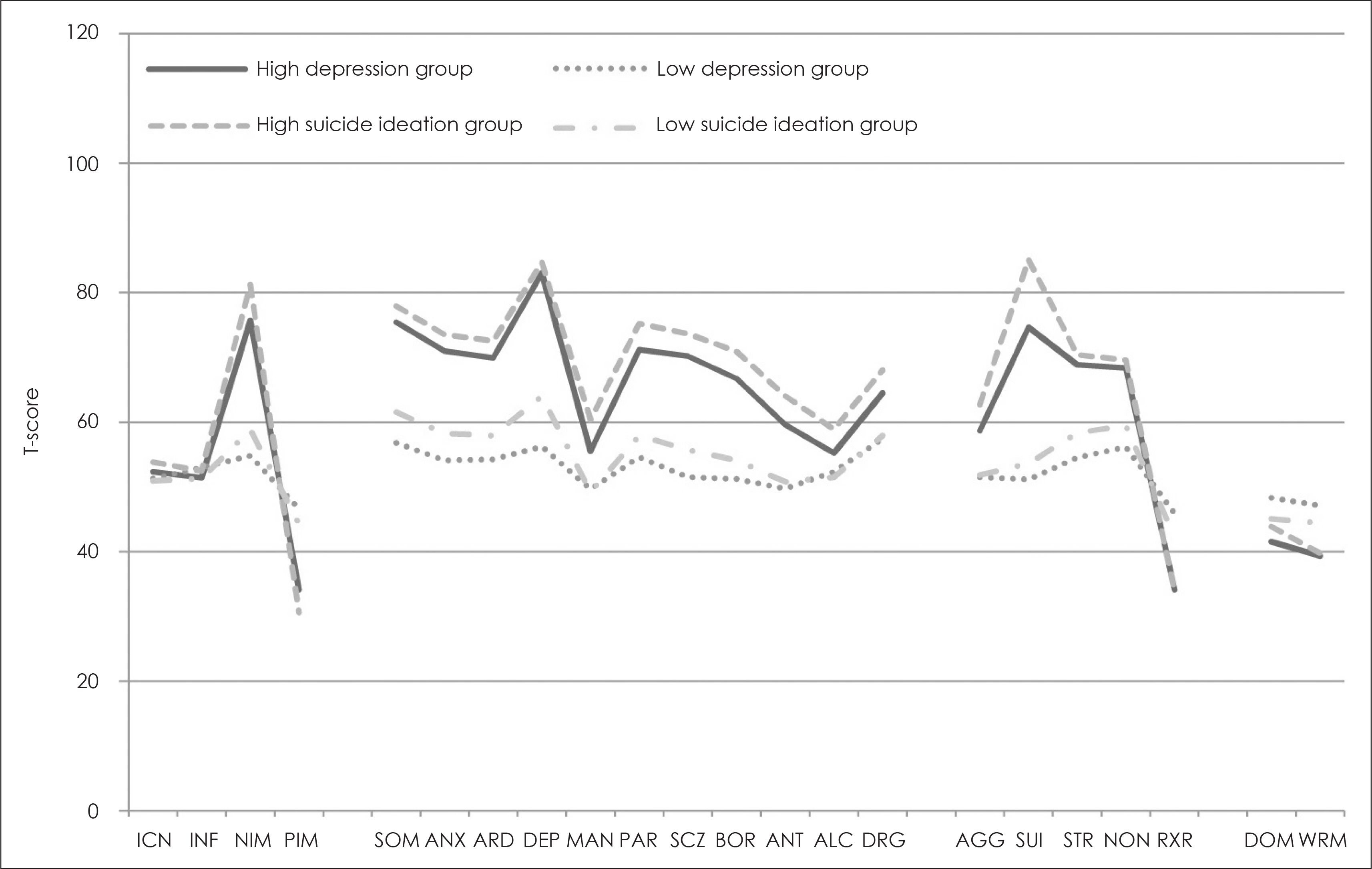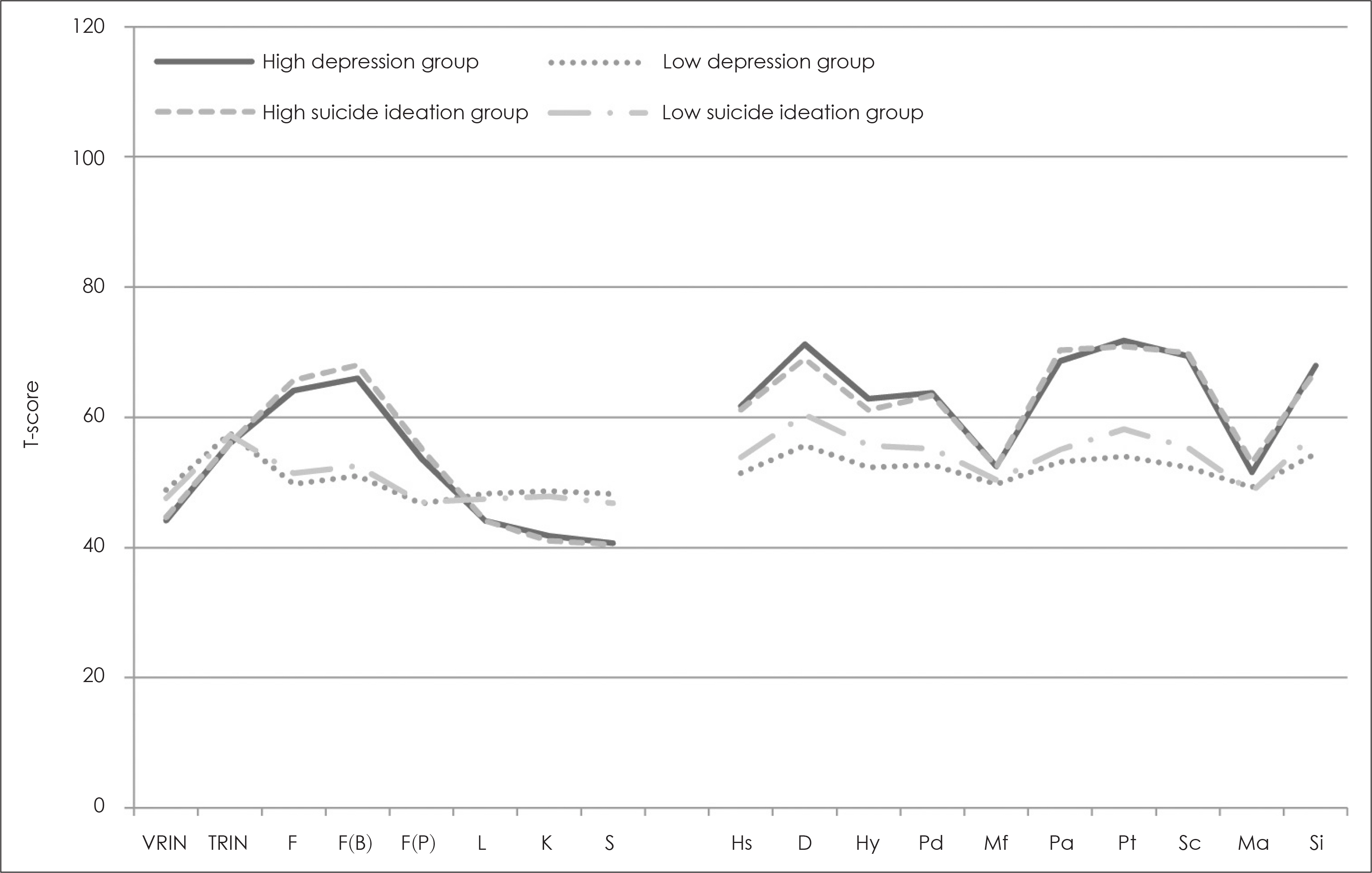J Korean Neuropsychiatr Assoc.
2018 Feb;57(1):86-95. 10.4306/jknpa.2018.57.1.86.
Comparative Study on Personality Assessment Inventory and MMPI-2 Profiles of Groups with High and Low Depression and Suicide Ideation in Psychiatry Patients and Discriminant Variables of Depression and Suicide Ideation
- Affiliations
-
- 1Department of Neuropsychiatry, Eulji University Hospital, Daejeon, Korea. hy6611@eulji.ac.kr
- KMID: 2405534
- DOI: http://doi.org/10.4306/jknpa.2018.57.1.86
Abstract
OBJECTIVES
The purpose of this study was to compare psychological test profiles of psychiatric outpatients with high and low depression/suicide ideation and to identify predictor variables for depression/suicide ideation.
METHODS
Component scores of the Personality Assessment Inventory (PAI) and Minnesota Multiphasic Personality Inventory-2 (MMPI-2) were compared using t-tests. Discriminant analysis was conducted for predictor variables of depression/suicide ideation.
RESULTS
Regarding PAI profiles, somatic complaints (SOM), anxiety (ANX), anxiety-related disorder (ARD), depression (DEP), paranoia (PAR), borderline features (BOR), antisocial features (ANT), mania (MAN) drug problems (DRG) scores were significantly elevated in high depression and high suicide ideation groups. Concerning MMPI-2 profiles, the scores of hypochondriasis (Hs), depression (D), hysteria (Hy), psychopathic deviate (Pd), paranoia (Pa), psychasthenia (Pt), schizophrenia (Sc), social introversion (Si) were significantly elevated in these same groups. The PAI and MMPI-2 profile shapes were remarkably similar between high depression and high suicide ideation groups. Therefore, in terms of psychological profile, depression and suicidal ideation seemed to reflect the same construct. However, in discriminant analysis, significant predictors for depression were found to be Pt and D Sc from MMPI-2, while those for suicide ideation were found to be Pa and Sc, suggest subtle differences.
CONCLUSION
The superficial characteristics of depression and suicide ideation groups reflected by the psychological test profiles seemed similar, but the determining factors may differ. Thus, the psychological interventions for these two groups may have to follow different routes considering these subtle differences.
Keyword
MeSH Terms
Figure
Reference
-
1). Hawton K, van Heeringen K. The international handbook of suicide and attempted suicide. Chichester: John Wiley & Sons, LTD;2000.2). Stewart D, Ross J, Watson C, James K, Bowers L. Patient characteristics and behaviours associated with self-harm and attempted suicide in acute psychiatric wards. J Clin Nurs. 2012; 21:1004–1013.
Article3). Kahng SK. Does depression predict suicide?: gender and age difference in the relationship between depression and suicidal attitudes. Korean J Soc welf Stud. 2010; 41:67–100.4). Han KS, Park YH, Im HS, Ju GY, Bae MH, Kang HC. Hope, depression and suicidal ideation in chronic mental illness patients. J Korean Acad Psychiatr Ment Health Nurs. 2010; 19:205–211.
Article5). Choi JW. Study of suicide death rate for suicide attempters, psychiatry emergency room visitors and psychiatry inpatients [dissertation]. Seoul: Ulsan University;2010.6). Nock MK, Borges G, Bromet EJ, Cha CB, Kessler RC, Lee S. Suicide and suicidal behavior. Epidemiol Rev. 2008; 30:133–154.
Article7). Jae YM. Suicide and psychiatric disorder. J Korean Soc Biol Ther Psychiatry. 2004; 10:3–10.8). Harwood D, Jacoby R. Suicidal behaviour among the elderly. Hawton K, van Heeringen K, editors. editors.The international handbook of suicide and attempted suicide. Chichester: John Wiley & Sons, LTD;2000. p. 275–292.
Article9). Kaplan ML, Asnis GM, Sanderson WC, Keswani L, De Lecuona JM, Joseph S. Suicide assessment: clinical interview vs. self-report. J Clin Psychol. 1994; 50:294–298.
Article10). Lee SA, Kim KH, Suh SY. Comparison of emotional and psychological characteristics between suicide attempters and non-attempters in depressed patients: using MMPI-2 profiles. Korean J Psychosom Med. 2012; 20:40–49.11). Han KH, Lim JY, Min BB, Lee JH, Moon KJ, Kim ZS. Korean MMPI-2 standardization study. Korean J Clin Psychol. 2006; 25:533–564.12). Lee K, Lee HK, Kim SH, Jang EY, Kim D. Suicide risk and the MMPI-2 findings among college students. Anxiety mood. 2015; 11:120–128.13). Kim YH, Kim JH, Oh SW, Lim YR, Hong SH. Standardization study of personality assessment inventory (PAI): reliability and validity. Korean J Clin Psychol. 2001; 20:311–329.14). Kim YH, Oh SW, Hong SH, Park EH. The clinical interpretation of PAI. Seoul: Hajisa;2002.15). Nichols DS. Essentials of MMPI-2 assessment. Hoboken, NJ: John Wiley & Sons;2011.16). Graham JR. MMPI-2: assessing personality and psychopathology. New York, NY: Oxford University Press;1990.17). Daigle M. MMPI inmate profiles: suicide completers, suicide attempters, and non-suicidal controls. Behav Sci Law. 2004; 22:833–842.
Article18). Pompili M, Rihmer Z, Akiskal HS, Innamorati M, Iliceto P, Akiskal KK, et al. Temperament and personality dimensions in suicidal and nonsuicidal psychiatric inpatients. Psychopathology. 2008; 41:313–321.
Article19). Seo HC, Oh SB, Kim TH, Lee JH, Kang SH, Lim MH. MMPI characteristics of the suicide attempter visiting emergency unit. Anxiety Mood. 2012; 8:79–85.20). Jeon EY, Lee DH, Lee JL, Kim SH. MMPI-2 profile differences between depressive disorders and anxiety disorders. Korea J Couns. 2013; 14:555–572.
Article21). Eisenberg D, Hunt J, Speer N. Mental health in American colleges and universities: variation across student subgroups and across campuses. J Nerv Ment Dis. 2013; 201:60–67.22). Lee EH. Life stress and depressive symptoms among college students: testing for moderating effects of coping style with structural equations. Korean J health psychol. 2004; 9:25–48.23). Abdallah T. Reliability and validity of Palestinian Student Alienation Scale. Adolescence. 1997; 32:367–371.24). Langhinrichsen-Rohling J, Arata C, Bowers D, O'Brien N, Morgan A. Suicidal behavior, negative affect, gender, and self-reported delinquency in college students. Suicide Life Threat Behav. 2004; 34:255–266.25). Nutbeam D, Smith C, Moore L, Bauman A. Warning! Schools can damage your health: alienation from school and its impact on health behaviour. J Paediatr Child Health. 1993; 29(Suppl 1):S25-S30.
Article26). Kopper BA, Osman A, Osman JR, Hoffman J. Clinical utility of the MMPI-A content scales and Harris-Lingoes subscales in the assessment of suicidal risk factors in psychiatric adolescents. J Clin Psychol. 1998; 54:191–200.
Article
- Full Text Links
- Actions
-
Cited
- CITED
-
- Close
- Share
- Similar articles
-
- Psychological Characteristics of Patients in Depression with High Suicide Risk: Using MMPI-2-RF
- A Study on the Suicide Ideation of Social Phobia Patients
- The Impact of Religiosity on Suicide Ideation & Related Variables in the Aged Dwelling in Community
- Personality Assessment Inventory Profiles of Patients with Mild and Severe Traumatic Brain Injury
- Influence of Job Stress and Depression on Suicide Ideation of Women-workers in Service Industries



